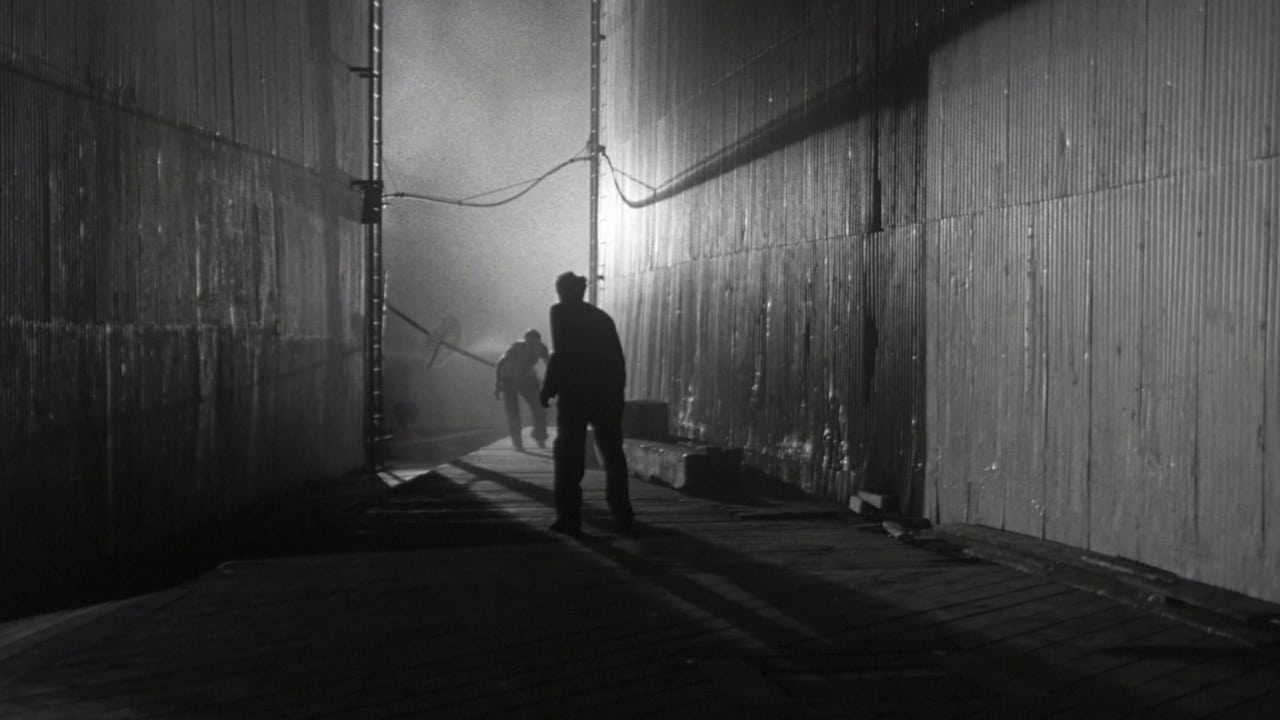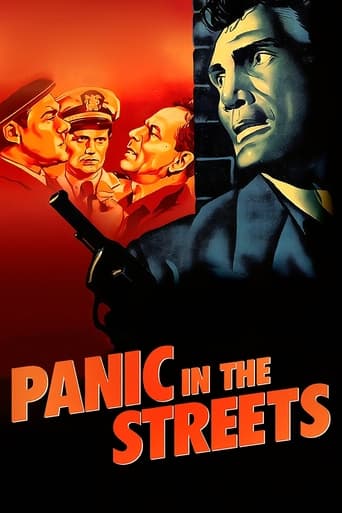



Purely Joyful Movie!
A Surprisingly Unforgettable Movie!
I really wanted to like this movie. I feel terribly cynical trashing it, and that's why I'm giving it a middling 5. Actually, I'm giving it a 5 because there were some superb performances.
View MoreThis movie feels like it was made purely to piss off people who want good shows
View MoreBeing an Elia Kazan film I always wonder if the film about an immigrant carrying a deadly disease which spreads like a contagion has hidden meanings of Europeans bringing communism to American shores!This black and white thriller has a doctor and a cop trying to locate people with a plague like disease because they came into contact with the carrier and trying to find out more about him. Richard Widmark is the intense doctor who realises the danger the city is in and tries to get the police interested to the dangers.On the other end its also a noir crime story as we have Jack Palance as a local hoodlum prowling the streets looking for one of his gang members who he thinks has double crossed him and assisted by his lackey Zero Mostel. Palance in his debut film dominates with his big muscular frame, he has a raw energy of the kind Widmark once displayed when he played villains.The story is intense as although the carrier has been killed early on the people he came into contact with start to fall ill and its a race against time. The film lulls a little with Widmark getting frustrated with scenes in his home life. The pace always picks up when Palance appears.
View MoreWhen an immigrant is found shot to death in the docks, the cause of death is given as gun shot wounds. The coroner, however, notices signs of something far more sinister - the pneumonic plague. Lt. Commander Reed (Richard Widmark), a doctor with the U.S. Public Health Service, is brought in to investigate the matter and contain any possible signs of infection. With the backing of the mayor, Reed faces scepticism from the police, and namely Captain Tom Warren (Paul Douglas), with whom he is forced to conduct the investigation with. With a prediction of 48 hours until the disease starts to spread, Reed and Warren are forced into a desperate rush to find the killers with next to nothing to go on.In contrast to the usual genre traits of film noir, Panic in the Streets makes the fine comparison between crime and disease, being very much one and the same. In order to prevent a deadly outburst, Reed must trace the dead body back to the intimidating Blackie (played with chiselled brooding menace by Jack Palance, he credited as Walter Jack Palance), who in the climatic scenes, scuttles across the floor as he desperately tries to evade the pursuing police like the rats that brought the bubonic plague to Europe in the 1300's. It's almost a strange subject to tackle within the confines of film noir, but if anything, heightens the intensity of the film, and with Elia Kazan's fine direction, the film becomes a fine metaphor for inner-city crime spreading like a cancer.Coming three years after his shockingly evil turn in Henry Hathaway's Kiss of Death (1947), that earned him an Oscar nomination, here Widmark is our hero and the man standing in the way of mass infection. Rather than the quick-tongued, hard-drinking and chain-smoking anti-hero's of most noirs, Reed is the one voice of sanity, fighting the system and finding comfort with his wife (played by Barbara Bel Geddes) at home. The few scenes that see Reed talk with his wife are a stark contrast and a welcome break from the documentary-style realism of Reed's investigations, a technique carried on from Jules Dassin's ground- breaking The Naked City (1948). Beginning with a smoky card-game played out with sweaty heavies (including Zero Mostel in a fantastic slimy role), the New Orleans' streets are shot in high contrast black-and- white, with sweeping cinematography that brings to mind the majestic tracking shot from Touch of Evil (1958).Although it pains me to say it - given his unforgivable outing of his friends and colleagues in the House Committee on Un-American Activities as being communists, leading to the black-listing and career deaths of many great artists - Kazan is a master of his medium. Yes, it's far from being one of the all-time great noirs, but Panic in the Streets is simply a finely polished and expertly paced thriller, squeezing out tension from the tiniest of moments, and bringing real originality to the genre. This is the not the Hollywood noir of Humphrey Bogart, but an honest and gravelly depiction of a city from the mayor down to the scum, with a apprehensive lone hero beating at its heart.www.the-wrath-of-blog.blogspot.com
View More"Panic in the Streets" stars Jack Palance as a violent criminal infected with a deadly airborne virus. As Jack travels throughout the New Orleans underworld, this virus spreads, infecting all whom he comes into contact with. On the case are Lt. Commander Dr. Clinton Reed (Richard Widmark) of the U.S. Public Health Service and New Orleans Police Captain Tom Warren (Paul Douglas). The virus could turn epidemic within 48 hours. It's imperative that they catch Palance and halt the spread of the disease.Narrative wise, the film merges police procedurals, socially conscious message movies (which were all the rage in the 1950s) and film noirs. Aesthetically, it mixes cinema verite with German expressionism. These juxtapositions gives rise to an odd cocktail: though shot on locations, and making heavy use of New Orlean's residents for both crowd scenes and speaking roles, the film's semi-documentary style is frequently interrupted by more expressionistic flourishes (ominous shadows, creepy dwarfs etc). End result: a fast paced race against time elevated by director Elia Kazan's hybrid style.Kazan was at the top of his game during this period, so the film flows like breeze, with pacey dialogue, atmospheric locations, great camera work and excellent cinematography by Joseph MacDonald. Lighting such vast, outdoor locations (dockyards, warehouses, ports etc) whilst retaining a consistently deep focus must have been a nightmare for MacDonald.More problematic is Kazan's supposed pandering to the House Un-American Activities Committee. In this regard, his characters never cease reminding us that they're all dutifully suffering poor wages and long working houses for the Greater Good. The film even has a subplot in which a news reporter, who wears his "Freedom of Speech" as a badge of honour, is shut down and locked away in a jail. There are some things the public doesn't need to know, the film says, and positions us to agree with. One thus can't help but feel that "Panic in the Streets" is Kazan's apology for his earlier flirtations with communism; the panic (communist infestations?) in the streets is warranted, the film says, but our hardworking boys have it all under control.8/10 - Worth one viewing.
View MoreLt. Cmdr. Clinton (Richard Widmark) is a military doctor who has the ungrateful duty of tracking down the killers of a mysterious foreign man who carried a deadly plague and now this disease might be spreading around the city, and Clinton must find everybody who had contact with the deceased in less than 48 hours before the news and the disease cause panic in the streets. Elia Kazan's "Panic in the Streets" is a good and original story at the time of its release about the difficulties of medical, political and law enforcement institutions in their mission of controlling things before they get out of control. In the story, Widmark's character not only has to find these guys, but he has to deal with bureaucracy among politics, journalists who sees in this case a great story to be published and that might alarm the people in a bad way, and the only help he's gonna get is with some people in the crowd who might have known the mysterious man, and help of a chief of police (Paul Douglas) who's not much cooperative at first so it's gonna take time to solve things but they don't have enough time to fulfill their task.The treatment given to the story wasn't too much interesting with its division of characters and situations. The chase for the "infecteds" was the most thrilling and interesting part of the plot; while the others involving Clinton's family and the bad guys played by Jack Palance and Zero Mostel, almost dragged the film into a boring and tiresome experience. Looking at the film in its surface it's very plausible but with some arguable problems. These guys are out there, they had contact the infected man, they walk to several places, talk to other people and they're spreading the plague, so how come only they had the disease and almost no one else does it too? I mean, the script was too much light and positive (yeah, I know it's the 1950's so they couldn't be so depressive showing that a disease could devastate a whole city), it wasn't realistic enough in this matter and it should be. People complain about the energetic "Outbreak" (1995) but that was a more effective film than this one, it had action, suspense, and also a run against the clock in order to stop a disease that was killing thousands of people. The climatic ending was great, with a long chase in the docks; and some dialog exchange between Douglas and Widmark was brilliant, funny and thoughtful. For what it tends to do it is a very good film and nothing more than that. But we know that Kazan has better works than this. 7/10
View More